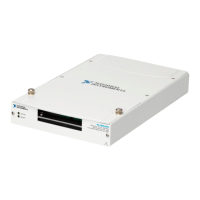Chapter 3 Connector and LED Information
© National Instruments Corporation 3-3 M Series User Manual
AO <0..3> AO GND Output Analog Output Channels 0 to 3—These terminals
supply the voltage output of AO channels 0 to 3.
AO GND — — Analog Output Ground—AO GND is the reference for
AO <0..3>. All three ground references—AI GND,
AO GND, and D GND—are connected on the device.
D GND — — Digital Ground—D GND supplies the reference
for P0.<0..31>, PFI <0..15>/P1/P2, and +5 V. All
three ground references—AI GND, AO GND, and
D GND—are connected on the device.
P0.<0..31> D GND Input or
Output
Port 0 Digital I/O Channels 0 to 31—You can
individually configure each signal as an input or output.
APFI <0..1> AO GND/AI GND Input Analog Programmable Function Interface Channels
0 to 1—Each APFI signal can be used as AO external
reference inputs for AO <0..3>, AO external offset input,
or as an analog trigger input. APFI <0..1> are referenced
to AI GND when they are used as analog trigger inputs.
APFI <0..1> are referenced to AO GND when they are
used as AO external offset or reference inputs. These
functions are not available on all devices. Refer to the
specifications for your device.
+5 V D GND Input or
Output
+5 V Power Source—These terminals provide a fused
+5 V power source.
PFI <0..7>/P1.<0..7>
PFI <8..15>/P2.<0..7>
D GND Input or
Output
Programmable Function Interface or Digital I/O
Channels 0 to 7 and Channels 8 to 15—Each of these
terminals can be individually configured as a PFI
terminal or a digital I/O terminal.
As an input, each PFI terminal can be used to supply an
external source for AI, AO, DI, and DO timing signals or
counter/timer inputs.
As a PFI output, you can route many different internal AI,
AO, DI, or DO timing signals to each PFI terminal. You
also can route the counter/timer outputs to each PFI
terminal.
As a Port 1 or Port 2 digital I/O signal, you can
individually configure each signal as an input or output.
USER <1..2> — — User-Defined Channels 1 and 2—On USB-62xx BNC
devices, the USER <1..2> BNC connectors allow you to
use a BNC connector for a digital or timing I/O signal of
your choice. The USER <1..2> BNC connectors are
internally routed to the USER <1..2> screw terminals.
Table 3-1. I/O Connector Signals (Continued)
Signal Name Reference Direction Description

